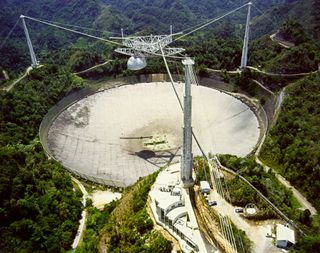Weird Radio Signals Detected from Nearby Red Dwarf Star

Strange radio signals have been spotted coming from the vicinity of a nearby star — but don't get your hopes up that aliens are responsible.
On May 12, the 1,000-foot-wide (305 meters) Arecibo radio telescope in Puerto Rico detected "some very peculiar signals" apparently emanating from Ross 128, a red dwarf star that lies just 11 light-years from Earth.
"The signals consisted of broadband quasi-periodic nonpolarized pulses with very strong dispersion-like features," Abel Mendez, director of the Planetary Habitability Laboratory at the University of Puerto Rico, wrote in a statement late last week. [13 Ways to Hunt Intelligent Aliens]
"We believe that the signals are not local radio frequency interferences (RFI) since they are unique to Ross 128, and observations of other stars immediately before and after did not show anything similar," he added.
The three leading explanations for the signals, Mendez wrote, are solar flare-like emissions from Ross 128, emissions from some other object in the same field of view and a burst of some sort from a satellite orbiting high above Earth.
But if you're getting the urge to invoke E.T., temper it: "In case you are wondering, the recurrent aliens hypothesis is at the bottom of many other better explanations," Mendez wrote.
Figuring out the signal's source will require more data, and Mendez and his team already have some in hand. The researchers carried out a successful observation of Ross 128 — as well as of Barnard's Star, a red dwarf located just 6 light-years from Earth — using the Arecibo dish yesterday (July 16), Mendez announced on Twitter yesterday. (These Arecibo observations are all part of a campaign to better understand the radiation and magnetic environments of red dwarfs, and to look for signs of undiscovered planets orbiting them, Mendez explained in his statement about the Ross 128 signals.)
Get the Space.com Newsletter
Breaking space news, the latest updates on rocket launches, skywatching events and more!
Other research teams are following up as well. For example, scientists with the SETI (Search for Extraterrestrial Intelligence) Institute have already begun observing Ross 128 with the Allen Telescope Array, a network of 42 radio dishes in northern California, said Seth Shostak, a senior astronomer at the SETI Institute.
Like Mendez, Shostak said that aliens are unlikely to be the cause of the Ross 128 signal.
"It does look like the kind of broadband interference that you get in SETI experiments," Shostak told Space.com.
Astronomer Douglas Vakoch, president of the San Francisco-based nonprofit METI (Messaging Extraterrestrial Intelligence), shared similar sentiments.
"There's nothing about these observations from May that resembles the sort of narrowband signal typically sought by radio SETI projects — a signal designed specifically to stand out against the cosmic static created by nature," Vakoch told Space.com via email. "Beyond that, the signal hasn't even been replicated — a fundamental requirement for a credible signal from an extraterrestrial civilization."
In addition, Ross 128 has been studied repeatedly by SETI scientists, Vakoch said.
"On five separate occasions in the past, METI's Optical SETI Observatory in Panama has scanned this star for brief laser pulses — all with no indication whatsoever that E.T. is calling," he said. "If there's an extraterrestrial civilization around this red dwarf in our galactic backyard, it seems like it's staying very quiet."
All of that being said, the E.T. hypothesis should not be dismissed, Shostak stressed.
"The historic lesson is clear — these things pop up, and you have to follow them up, because you never know what's going to be the real one, or even if there will ever be a real one," Shostak told Space.com. "Following up is mandatory."
Editor's note: This story was updated at 5:30 p.m. EDT to include statements from Douglas Vakoch.
Follow Mike Wall on Twitter @michaeldwall and Google+. Follow us @Spacedotcom, Facebook or Google+. Originally published on Space.com.
Join our Space Forums to keep talking space on the latest missions, night sky and more! And if you have a news tip, correction or comment, let us know at: community@space.com.

Michael Wall is a Senior Space Writer with Space.com and joined the team in 2010. He primarily covers exoplanets, spaceflight and military space, but has been known to dabble in the space art beat. His book about the search for alien life, "Out There," was published on Nov. 13, 2018. Before becoming a science writer, Michael worked as a herpetologist and wildlife biologist. He has a Ph.D. in evolutionary biology from the University of Sydney, Australia, a bachelor's degree from the University of Arizona, and a graduate certificate in science writing from the University of California, Santa Cruz. To find out what his latest project is, you can follow Michael on Twitter.
